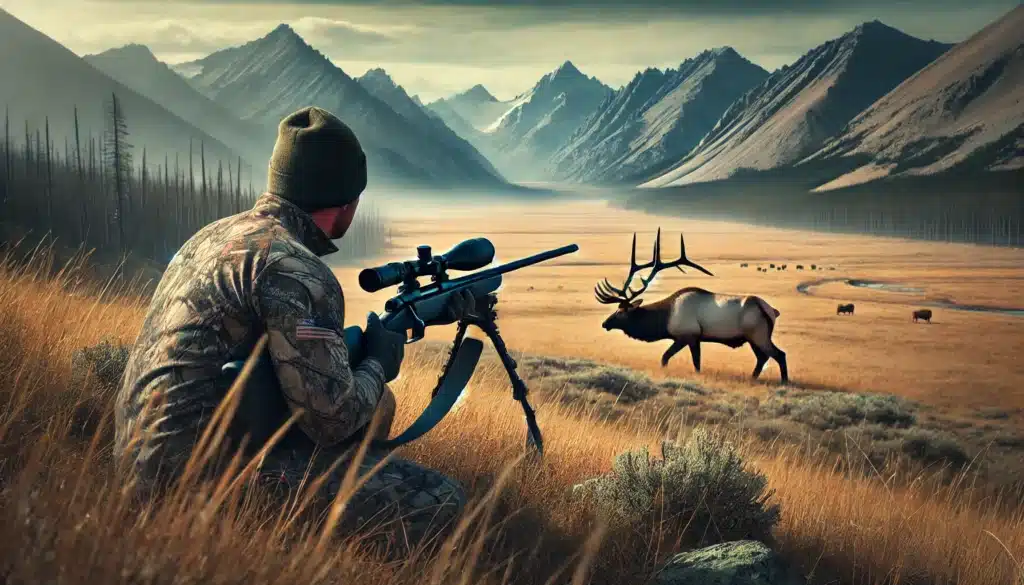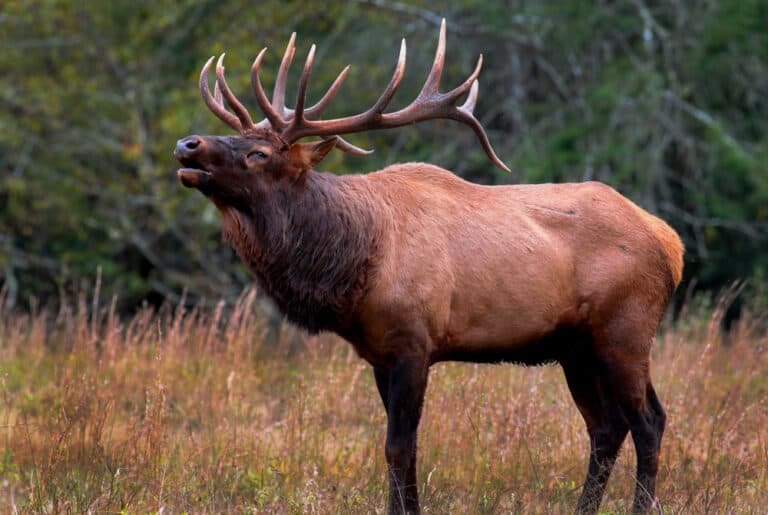Best Long Range Elk Rifle: 5 Hard Truths About Rifles
That bull elk standing at 750 yards across the canyon might as well be on the moon if you’re not properly equipped and trained. After spending $4,000 on a precision rifle setup, I learned this lesson the hard way, only to realize the gear was way ahead of my skills. Let’s review the best long range elk rifle options so this doesn’t happen to you.

Here’s the uncomfortable truth about long-range elk hunting that most people won’t tell you: just because you can shoot that far doesn’t mean you should. But if you’re committed to doing it right, this guide will help you understand what it takes – both in gear and dedication.
I’ve spent the last decade teaching precision rifle courses and hunting elk across the West. What is the most common thing I hear from new long-range hunters? “I wish someone had told me what this requires before I spent all this money.”
In this guide, we’ll cut through the marketing hype and Instagram highlights to discuss:
- The real ethical considerations of long-range elk hunting
- What your rifle setup needs (and doesn’t need)
- How to choose the right scope and learn to use it
- The truth about wind reading and ballistics
- The training commitment required to be effective
Whether you’re considering entering long-range hunting or looking to improve your extended-range capabilities, this guide will give you the unvarnished truth about what it takes to make ethical shots at a distance.
The Ethics and Reality of Long Range Elk Hunting

Let’s start with the uncomfortable conversation that nobody wants to have: just because your rifle can shoot a mile doesn’t mean you should take that shot at a living animal. I’ve seen too many wounded elk from hunters who confused range day accuracy with hunting proficiency.
Defining “Long Range” For Elk
First, let’s get clear about what we mean by “long-range”:
- Traditional elk hunting: 0-300 yards
- Extended range: 300-500 yards
- True long range: 500+ yards
Real talk: If you can’t consistently hit a 12-inch plate at 300 yards in field conditions, you have no business shooting at elk beyond that range.
The Ethical Framework
Here’s what you need to guarantee before taking any long-range shot:
- 100% certainty of bullet placement in the vital zone
- Ability to follow up quickly if needed
- Full understanding of wind conditions
- Clear shooting lane for the entire bullet trajectory
- Stable shooting position
- Known distance to target
- Calm mental state
When to Pass on the Shot
You must be willing to say no when:
- The wind is gusting or unpredictable
- The animal is moving or likely to move
- You’re physically tired or shaking
- Light conditions are poor
- Can’t verify the clear path to the target
- Feeling pressured by others
- Any doubt about the situation
The Physical Requirements
Long-range hunting demands more than just good gear:
- Physical fitness to handle heavy rifles
- Ability to get into stable positions
- Core strength for extended holds
- Breathing control
- Steady hands under pressure
- Mental focus and discipline
Time Investment Reality Check
Before you buy that expensive rifle, understand the commitment:
- Minimum 1,000 rounds of practice annually
- Weekly dry fire practice
- Monthly range sessions
- Regular physical training
- Ballistics education
- Wind reading practice
Personal note: I spent two full seasons practicing before taking my first shot at an elk beyond 500 yards. That patience paid off with a clean, one-shot kill.
Optimal Rifle Configurations for Long-Range Success

The Hard Truth About Your Investment
Let me be blunt: long-range elk hunting isn’t cheap. You’re looking at a minimum $4,000 investment for a reliable rifle setup, and that’s before your scope. Here’s how to spend it wisely.
Caliber Selection
Top choices for long-range elk:
- 6.5 PRC: Best balance of recoil and power
- 28 Nosler: Hard-hitting but stiff recoil
- 300 PRC: Maximum power, maximum kick
- 7mm Rem Mag: Proven performer
Action Requirements
- Controlled round feeding preferred
- Smooth bolt operation
- Rigid bedding system
- Quality steel or titanium construction
- Repeatable lockup
Barrel Specifications
- 24-26 inch length
- Heavy or medium-heavy contour
- Match-grade steel
- Professional lapping and crowning
- Threaded for brake or suppressor
Top Rifle Recommendations: Premium Tier
1. Proof Research Mesa

- Carbon fiber barrel
- Incredible accuracy
- Lightweight for power
- Weather resistant
- Drawback: Price tag hurts
2. GA Precision GAP Delta

- Custom quality
- Outstanding support
- Match grade everything
- Drawback: Long wait times
Mid-Range ($2,000-3,000)
1. Bergara Premier HMR Pro

- Outstanding value
- Great factory trigger
- Sub-MOA guarantee
- Drawback: On the heavy side
2. Savage 110 Elite Precision

- Excellent accuracy
- Great factory support
- User-adjustable everything
- Drawback: Looks aren’t for everyone
Essential Accessories
Muzzle Devices
- Quality brake is mandatory
- Consider a suppressor for practice
- Plan on $200-400 here
Bipod
- Atlas or Harris mandatory
- No cheap alternatives
- Budget $200-300
Base & Rings
- Only premium quality
- 20-30 MOA base minimum
- Lapping required
- Plan on $300-400
Building vs. Buying
Factory Custom Benefits
- Warranty coverage
- Known performance
- Faster delivery
- Professional assembly
Custom Build Benefits
- Everything chosen by you
- Potential cost savings
- Better parts availability
- Future upgrade path
Personal approach: I run a GAP Delta because I’d rather spend time practicing than tweaking my rifle.
Optics: The Most Critical Investment
The Truth About Long Range Scopes
Reality check: I’ve seen more hunts ruined by cheap scopes than any other gear failure. This is not where you cut corners.
Minimum Scope Requirements
Essential Features
- 30mm or 34mm tube
- First focal plane reticle
- Exposed turrets
- Zero stop
- Minimum 18x magnification
- Quality glass (ED or HD)
- Reliable tracking
Price Point Reality
Let’s be brutally honest about budgets:
- Under $1,000: Not adequate for long range elk
- $1,500-2,500: Minimum viable options
- $2,500-3,500: Sweet spot for value
- $3,500+: Premium territory
Top Scope Recommendations
Premium Options ($2,500+)
Nightforce ATACR 5-25×56
- Gold standard for reliability
- Outstanding glass
- Bomb-proof construction
- Perfect tracking
- Drawback: Weight and price
Leupold Mark 5HD 5-25×56
- Lighter than competitors
- Great glass clarity
- Proven track record
- Drawback: Higher price
Value Options ($900-2,500)
Vortex Viper PST Gen II 5-25×50
- Best value in class
- Good glass
- Solid tracking
- Great warranty
- Drawback: Heavier than premium options
ZEISS Conquest V4 6-24×50
- Excellent glass
- Good reticle options
- Reliable tracking
- Drawback: Limited elevation travel
Setting Up Your Optic
Mounting Process
- Proper torque sequence
- Lapping rings
- Leveling process
- Thread locker application
Zero Process
- Mechanical zero verification
- 100-yard zero
- Long-range confirmation
- Tracking test
- Zero stop setting
Understanding Your Reticle
Must-Know Features
- Mil vs MOA (pick one, stick with it)
- Holdover points
- Wind holds
- Ranging features
Learning Your System
- Range estimation drills
- Hold practice
- Quick adjustment drills
- Position transition practice
Field Ready Checks
- Zero confirmation
- Turret function
- Focus adjustment
- Weather sealing
- Backup battery
- Lens covers
Wind Reading and Ballistics: The True Challenge

Personal admission: After a decade of long-range shooting, wind calls still humbled me. Anyone who says they’ve mastered wind reading is lying or trying to sell you something.
The Brutal Math (Example at 800 yards with 6.5 PRC)
- 10 mph full value wind = 19″ drift
- Error in wind call by five mph = missed elk
- Multiple wind values between you and the target
- Changing conditions during bullet flight
Wind Reading Fundamentals: Visual Indicators (Nearest to Farthest)
Grass movement (0-100 yards)
- Barely moving = 3-5 mph
- Constant bend = 10-12 mph
- Laying flat = 20+ mph
Tree branches/leaves (100-300 yards)
- Small twigs moving = 5-8 mph
- Branches swaying = 12-15 mph
- Entire tree moving = 20+ mph
Mirage (100-600 yards)
- Standing = 0-3 mph
- 15° angle = 5-8 mph
- 30° angle = 8-12 mph
- Broken/choppy = 12+ mph
Dust/Vegetation (300+ yards)
- Watch particle movement
- Note different winds at different ranges
Practical Ballistics

Data Collection Requirements
- Accurate range
- Temperature
- Pressure
- Humidity
- Density altitude
- Wind speed and direction
- Shooting angle
Essential Tools
- Quality rangefinder ($400+ minimum)
- Reliable ballistic calculator
- Weather meter ($300+ minimum)
- Field data book
- Backup battery pack
Building Your DOPE
(Data On Previous Engagements)
- Gather cold bore data
- Confirm drops at distance
- Record wind holds
- Document ammunition lot
- Note temperature effects
- Track pressure changes
Field Application

Pre-Shot Checklist
- Range to target
- Collect weather data
- Input to calculator
- Verify clear flight path
- Assess wind values
- Determine hold/adjustment
- Confirm position stability
- Take reading at multiple ranges
Common Mistakes
- Focusing only on target area wind
- Ignoring angle effects
- Not updating data
- Rushing the process
- Overconfidence in calculations
Real scenario: Last season, I watched a perfect wind call turn into a miss because I didn’t notice a thermal development in the canyon between me and the elk.
Training Requirements: The Path to Competence

The Commitment to Excellence
Hard truth: Long-range elk hunting isn’t for you if you’re not willing to dedicate at least one weekend a month to training. I’ve seen too many hunters learn this the hard way.
Dry Fire Practice (3x Weekly Minimum)
Position Building
- Prone
- Seated
- Tripod supported
- Improvised positions
Trigger Control Drills
- Slow squeeze exercises
- Reset practice
- Follow-through training
- Cold bore simulation
Wind Reading Practice
- Mirage reading
- Flag observation
- Natural indicator study
- Multiple value estimation
Live Fire Requirements (Monthly Minimum)
Cold Bore Shot
- Document conditions
- Record performance
- Analyze results
Position Training
- 20 rounds prone
- 20 rounds seated
- 20 rounds improvised
- Time pressure drills
Distance Progression
- Confirm zero at 100
- Verify drops at a distance
- Practice wind holds
- Target transition drills
Physical Training Requirements
Core Strength (2x Week)
- Plank progressions
- Side planks
- Russian twists
- Dead bugs
Cardio (3x Week)
- Hill climbs with gear
- Weighted hikes
- High-intensity intervals
- Recovery work
Flexibility (Daily)
- Hip mobility
- Shoulder stability
- Core rotation
- Breathing exercises
Mental Preparation
Stress Management
- Breathing techniques
- Shot process visualization
- Decision-making under pressure
- No-shoot scenarios
Common Mistakes
- Focus on target area wind
- Ignoring angle effects
- Rushing the process
- Overconfidence in calculations
Data Management
- Maintaining detailed logs
- Weather tracking
- Performance analysis
- Equipment updates
Realistic Goals and Progression
Month 1-3
- Master fundamentals to 300 yards
- Build position stability
- Learn wind reading basics
- Establish fitness baseline
Month 4-6
- Extend range to 500 yards
- Complex position work
- Wind calling practice
- Build physical stamina
Month 7-9
- Push to intended hunting ranges
- Environmental challenges
- Stress shooting
- Fieldcraft integration
Month 10-12
- Hunt scenario practice
- Full gear integration
- Terminal ballistics study
- Ethics reinforcement
Measuring Progress: Key Performance Indicators
Group Size Standards
- Sub-MOA at 100 yards
- 2 MOA max at distance
- Consistent first-round hits
Time Standards
- Range estimation under 30 seconds
- Wind call under 1 minute
- Position built under 45 seconds
- Target engagement in under 2 minutes
Physical Standards
- Pack rifle system 2 miles
- Hold steady for 3 minutes
- Recover breathing in 30 seconds
Personal benchmark: You should be able to hit an 8-inch plate 8 out of 10 times at your maximum hunting distance before considering taking shots at elk at that range.
Making the Final Decision: Where Do You Stand?
Let me leave you with some straight talk that might prevent you from making costly mistakes—both financially and ethically.

The Three Pillars of Long Range Success
1. Equipment Readiness
- Complete rifle system ($4,000+)
- Quality optics ($2,500+)
- Support gear ($1,000+)
- Reliable ammunition supply
- Backup equipment
2. Skill Readiness
- Can you read the wind consistently?
- Do you maintain a training log?
- Are your groups consistent?
- Can you shoot from field positions?
- Do you practice regularly?
3. Mental Readiness
- will you pass on marginal shots?
- Can you handle buck fever at a distance?
- Do you trust your wind calls?
- Are you patient enough?
- Will you admit when conditions exceed your abilities?
Real-World Decision Making
Green Lights
✅ Take the shot when:
- Conditions are within your proven abilities
- Animal is stationary and broadside
- Wind is steady and readable
- You have a solid position
- Plenty of daylight remains
- You feel 100% confident
Red Flags
🚫 Pass on the shot when:
- Gusting or variable winds
- Animal is alert or moving
- Light is failing
- Position is unstable
- Feeling rushed or pressured
- Any doubt exists
Final Recommendations
For Those Just Starting
- Start with shorter ranges
- Invest in quality training
- Build skills progressively
- Document everything
- Find a mentor
For Experienced Hunters
- Be honest about limitations
- Maintain regular practice
- Update equipment thoughtfully
- Keep learning new techniques
- Share knowledge responsibly

Remember This Above All
A lesson learned the hard way: The most respected long-range hunters I know are the ones who pass on more shots than they take.
The true mark of a skilled long-range hunter isn’t the distance of their successful shots – it’s the wisdom to know when not to shoot.
Your reputation as a hunter, the ethical treatment of the animal, and the integrity of our sport all depend on making the right decisions when no one is watching.
Your Next Steps
- Evaluate your current situation honestly
- Create a realistic training plan
- Set clear equipment priorities
- Find qualified instruction
- Build skills methodically
- Practice relentlessly
Remember: Long-range elk hunting isn’t about proving anything to anyone. It’s about extending your effective range through dedication, training, and ethical decision-making.










